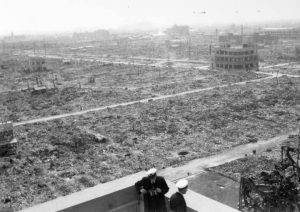Documenting Hiroshima of 1946: In February, beer hall provides refreshment to survivors living amid scorched ruins
Feb. 4, 2025
by Maho Yamamoto, Staff Writer
In February 1946, the Kirin Beer Hall, a business that had reopened a little more than one month prior in the area of Horikawa-cho (in Hiroshima City’s present-day Naka Ward), 670 meters from the hypocenter, provided refreshment to people still living amid the scorched ruins.
Construction on the Beer Hall, a three-story, steel-reinforced concrete building with a single basement floor, was completed in 1938. A subsidiary company of Kirin Brewery Co., Ltd. opened the hall as a restaurant, and it became a popular place for families to enjoy beer and food. Even during the war, a time when alcohol was rationed, the restaurant was crowded with people enjoying beer. The day of the atomic bombing was a regular holiday for the restaurant and, as such, no one was inside the building at the time. However, except for the basement, the building’s interior was completely burned out in the bombing. Despite that, the business managed to reopen on December 26, 1945.
The Kirin Brewery Hiroshima Factory, which had also been completed in 1938, was located in the town of Fuchu-cho, Hiroshima Prefecture. The factory served as the major supplier of beer for Hiroshima. Located around four kilometers from the hypocenter, the factory avoided major devastation, with only its windows and walls damaged. Five factory employees, who were within the city limits of Hiroshima on their way to work or otherwise, died in the bombing.
According to the Kirin Biru Hiroshima Kojo 50-nen Shi (in English, ‘Kirin Beer Hiroshima Factory 50-Year History’), published in 1988, “At the Hiroshima factory, there was an instinctive ‘desire to make beer.’” In December 1945, yeast was delivered from the Kanzaki Brewery in its location of Amagasaki City in Hyogo Prefecture on a packed train and hastily brought from Hiroshima Station to the Hiroshima Factory in preparation for brewing beer. In June 1946, they began production of beer for the occupation forces.
“Each glass of beer must have helped Hiroshima’s recovery. Beer was always at people’s side no matter their emotions at the time,” said Yutaka Shigetomi, 62, the third-generation owner of a liquor store in Hiroshima’s present-day Naka Ward. The Beer Hall building was torn down in 1991, but one part of it was preserved as a monument on the exterior wall of the main Hiroshima Parco building, which stands today on the Beer Hall’s former location.
(Originally published on February 4, 2025)
In February 1946, the Kirin Beer Hall, a business that had reopened a little more than one month prior in the area of Horikawa-cho (in Hiroshima City’s present-day Naka Ward), 670 meters from the hypocenter, provided refreshment to people still living amid the scorched ruins.
Construction on the Beer Hall, a three-story, steel-reinforced concrete building with a single basement floor, was completed in 1938. A subsidiary company of Kirin Brewery Co., Ltd. opened the hall as a restaurant, and it became a popular place for families to enjoy beer and food. Even during the war, a time when alcohol was rationed, the restaurant was crowded with people enjoying beer. The day of the atomic bombing was a regular holiday for the restaurant and, as such, no one was inside the building at the time. However, except for the basement, the building’s interior was completely burned out in the bombing. Despite that, the business managed to reopen on December 26, 1945.
The Kirin Brewery Hiroshima Factory, which had also been completed in 1938, was located in the town of Fuchu-cho, Hiroshima Prefecture. The factory served as the major supplier of beer for Hiroshima. Located around four kilometers from the hypocenter, the factory avoided major devastation, with only its windows and walls damaged. Five factory employees, who were within the city limits of Hiroshima on their way to work or otherwise, died in the bombing.
According to the Kirin Biru Hiroshima Kojo 50-nen Shi (in English, ‘Kirin Beer Hiroshima Factory 50-Year History’), published in 1988, “At the Hiroshima factory, there was an instinctive ‘desire to make beer.’” In December 1945, yeast was delivered from the Kanzaki Brewery in its location of Amagasaki City in Hyogo Prefecture on a packed train and hastily brought from Hiroshima Station to the Hiroshima Factory in preparation for brewing beer. In June 1946, they began production of beer for the occupation forces.
“Each glass of beer must have helped Hiroshima’s recovery. Beer was always at people’s side no matter their emotions at the time,” said Yutaka Shigetomi, 62, the third-generation owner of a liquor store in Hiroshima’s present-day Naka Ward. The Beer Hall building was torn down in 1991, but one part of it was preserved as a monument on the exterior wall of the main Hiroshima Parco building, which stands today on the Beer Hall’s former location.
(Originally published on February 4, 2025)








